The Response of Mixed Layer Depth Due to Hurricane Katrina (2005)
Abstract
:1. Introduction
2. General Background and Methods
2.1. Study Area
2.2. Hurricane Katrina (2005)
2.3. Model Configuration
2.4. Model Calibration
2.5. Model Skill Metrics
3. Results
3.1. Model Validations—Water Levels, Winds and Waves
3.2. Model Validations—Vertical Profiles of Salinity and Temperature
3.3. Vertical Variability of Salinity and Temperature
3.4. Mixed Layer Depth during Katrina
4. Further Discussion
4.1. MLD Recovery
4.2. Wave Effect on MLD
5. Conclusions
Author Contributions
Funding
Institutional Review Board Statement
Informed Consent Statement
Data Availability Statement
Acknowledgments
Conflicts of Interest
References
- Chen, D.; Busalacchi, A.J.; Rothstein, L.M. The roles of vertical mixing, solar radiation, and wind stress in a model simulation of the sea surface temperature seasonal cycle in the tropical Pacific Ocean. J. Geophys. Res. 1994, 99, 20345–20359. [Google Scholar] [CrossRef]
- Sutton, P.J.; Worcester, P.F.; Masters, G.; Cornuelle, B.D.; Lynch, J.F. Ocean mixed layers and acoustic pulse propagation in the Greenland Sea. J. Acoust. Soc. Am. 1993, 94, 1517–1526. [Google Scholar] [CrossRef]
- Arrigo, K.R.; Robinson, D.H.; Worthen, D.L.; Dunbar, R.B.; Ditullio, G.R.; Vanwoert, M.; Lizotte, M.P. Phytoplankton community structure and the drawdown of nutrients and CO2 in the southern ocean. Science 1999, 283, 365–367. [Google Scholar] [CrossRef] [PubMed]
- Fasham, M.J.R. Variations in the seasonal cycle of biological production in subarctic oceans: A model sensitivity analysis. Deep Sea Res. Part I Oceanogr. Res. Pap. 1995, 42, 1111–1149. [Google Scholar] [CrossRef]
- Helber, R.W.; Kara, A.; Barron, C.; Boyer, T. Mixed layer depth in the Aegean, Marmara, Black and Azov Seas: Part II: Relation to the sonic layer depth. J. Mar. Syst. 2009, 78, S181–S190. [Google Scholar] [CrossRef]
- Obata, A.; Ishizaka, J.; Endoh, M. Global verification of critical depth theory for phytoplankton bloom with climatological in situ temperature and satellite ocean color data. J. Geophys. Res. Oceans 1996, 101, 20657–20667. [Google Scholar] [CrossRef]
- Polovina, J.J.; Mitchum, G.T.; Evans, G.T. Decadal and basin-scale variation in mixed layer depth and the impact on biological production in the Central and North Pacific, 1960–1988. Deep Sea Res. Part I Oceanogr. Res. Pap. 1995, 42, 1701–1716. [Google Scholar] [CrossRef]
- Agrawal, Y.C.; Terray, E.A.; Donelan, M.A.; Hwang, P.A.; Williams, A.J.; Drennan, W.M.; Kahma, K.K.; Krtaigorodskii, S.A. Enhanced dissipation of kinetic energy beneath surface waves. Nature 1992, 359, 219–220. [Google Scholar] [CrossRef]
- Craik, A.D.; Leibovich, S. A rational model for Langmuir circulations. J. Fluid Mech. 1976, 73, 401–426. [Google Scholar] [CrossRef]
- Large, W.G.; McWilliams, J.C.; Doney, S.C. Oceanic vertical mixing: A review and a model with a nonlocal boundary layer parameterization. Rev. Geophys. 1994, 32, 363–403. [Google Scholar] [CrossRef]
- Mellor, G.L.; Durbin, P.A. The structure and dynamics of the ocean surface mixed layer. J. Phys. Oceanogr. 1975, 5, 718–728. [Google Scholar] [CrossRef]
- Pickard, G.; Emery, W. Descriptive Physical Oceanography: An Introduction By George L. Pickard Oxford: Pergamon Press1964. Pp. viii + 199. Price 25s. J. Mar. Biol. Assoc. UK 1964, 44, 758. [Google Scholar]
- Roden, G.I. The Depth Variability of Meridional Gradients of Temperature, Salinity and Sound Velocity in the Western North Pacific. J. Phys. Oceanogr. 1979, 9, 756–767. [Google Scholar] [CrossRef]
- Skyllingstad, E.D.; Paluszkiewicz, T.; Denbo, D.W.; Smyth, W.D. Nonlinear vertical mixing processes in the ocean: Modeling and parameterization. Phys. D Nonlinear Phenom. 1996, 98, 574–593. [Google Scholar] [CrossRef]
- Welander, P. Mixed Layers and Fronts in Simple Ocean Circulation Models. J. Phys. Oceanogr. 1981, 11, 148–152. [Google Scholar] [CrossRef]
- de Boyer Montégut, C.; Madec, G.; Fischer, A.S.; Lazar, A.; Iudicone, D. Mixed layer depth over the global ocean: An examination of profile data and a profile-based climatology. J. Geophys. Res. Ocean. 2004, 109. [Google Scholar] [CrossRef]
- Spall, M.A.; Weller, R.A.; Furey, P.W. Modeling the three-dimensional upper ocean heat budget and subduction rate during the Subduction Experiment. J. Geophys. Res. Ocean. 2000, 105, 26151–26166. [Google Scholar] [CrossRef]
- Thomson, R.E.; Fine, I.V. Estimating Mixed Layer Depth from Oceanic Profile Data. J. Atmos. Ocean. Technol. 2003, 20, 319–329. [Google Scholar] [CrossRef]
- Bhaskar, T.U.; Swain, D. Sonic Layer Depth estimated from XBT temperatures and climatological salinities. Nat. Preced. 2011. [Google Scholar] [CrossRef]
- Huang, R.X. Ocean Circulation: Wind-Driven and Thermohaline Processes; Cambridge University Press: Cambridge, UK, 2010. [Google Scholar]
- Murty, T.S.; El-Sabh, M.I. Storm tracks, storm surges and sea state in the Arabian Gulf, Strait of Hormuz and the Gulf of Oman. UNESCO Rep. Mar. Sci 1984, 28, 12–24. [Google Scholar]
- Schott, F.; Visbeck, M.; Send, U.; Fischer, J.; Stramma, L.; Desaubies, Y. Observations of deep convection in the Gulf of Lions, northern Mediterranean, during the winter of 1991/92. J. Phys. Oceanogr. 1996, 26, 505–524. [Google Scholar] [CrossRef]
- Lee, C.M.; Askari, F.; Book, J.; Carniel, S.; Cushman-Roisin, B.; Dorman, C.; Doyle, J.; Flament, P.; Harris, C.K.; Jones, B.H. Northern Adriatic response to a wintertime bora wind event. Eos Trans. Am. Geophys. Union 2005, 86, 157–165. [Google Scholar] [CrossRef]
- Jacob, S.D.; Shay, L.K.; Mariano, A.J.; Black, P.G. The 3D Oceanic Mixed Layer Response to Hurricane Gilbert. J. Phys. Oceanogr. 2000, 30, 1407–1429. [Google Scholar] [CrossRef]
- Shay, L.; Black, P.; Mariano, A.; Hawkins, J.; Elsberry, R. Upper ocean response to Hurricane Gilbert. J. Geophys. Res. Ocean. 1992, 97, 20227–20248. [Google Scholar] [CrossRef]
- Shay, L.K.; Goni, G.J.; Black, P.G. Effects of a Warm Oceanic Feature on Hurricane Opal. Mon. Weather Rev. 2000, 128, 1366–1383. [Google Scholar] [CrossRef]
- Uhlhorn, E.W.; Shay, L.K. Loop Current Mixed Layer Energy Response to Hurricane Lili (2002). Part I: Observations. J. Phys. Oceanogr. 2012, 42, 400–419. [Google Scholar] [CrossRef]
- Walker, N.D.; Leben, R.R.; Balasubramanian, S. Hurricane-forced upwelling and chlorophyll a enhancement within cold-core cyclones in the Gulf of Mexico. Geophys. Res. Lett. 2005, 32. [Google Scholar] [CrossRef]
- Jaimes, B.; Shay, L.K. Near-Inertial Wave Wake of Hurricanes Katrina and Rita over Mesoscale Oceanic Eddies. J. Phys. Oceanogr. 2010, 40, 1320–1337. [Google Scholar] [CrossRef]
- Jaimes, B.; Shay, L.K. Mixed layer cooling in mesoscale oceanic eddies during Hurricanes Katrina and Rita. Mon. Weather Rev. 2009, 137, 4188–4207. [Google Scholar] [CrossRef]
- Shay, L.K. Upper Ocean Structure: Responses to Strong Atmospheric Forcing Events. In Encyclopedia of Ocean Sciences; Elsevier Ltd.: Amsterdam, The Netherlands, 2009; pp. 192–210. Available online: http://www.scopus.com/inward/record.url?scp=84884459695&partnerID=8YFLogxK (accessed on 12 November 2021).
- Fedorov, K.N.; Varfolomeev, A.A.; Ginzburg, A.I. Thermal reaction of the ocean on the passage of hurricane Ella. Okeanologiya 1979, 19, 992–1001. [Google Scholar]
- Leipper, D.F. Observed ocean conditions and Hurricane Hilda, 1964. J. Atmos. Sci. 1967, 24, 182–186. [Google Scholar] [CrossRef]
- Black, P.G. Ocean temperature changes induced by tropical cyclones. Ph.D. Thesis, The Pennsylvania State University, State College, PA, USA, 1983. [Google Scholar]
- Brooks, D.A. The wake of Hurricane Allen in the western Gulf of Mexico. J. Phys. Oceanogr. 1983, 13, 117–129. [Google Scholar] [CrossRef]
- Shay, L.K.; Elsberry, R.L. Near-inertial ocean current response to Hurricane Frederic. J. Phys. Oceanogr. 1987, 17, 1249–1269. [Google Scholar] [CrossRef]
- Bender, M.A.; Ginis, I.; Kurihara, Y. Numerical simulations of tropical cyclone-ocean interaction with a high-resolution coupled model. J. Geophys. Res. Atmos. 1993, 98, 23245–23263. [Google Scholar] [CrossRef]
- Gierach, M.M.; Subrahmanyam, B.; Thoppil, P.G. Physical and biological responses to Hurricane Katrina (2005) in a 1/25 nested Gulf of Mexico HYCOM. J. Mar. Syst. 2009, 78, 168–179. [Google Scholar] [CrossRef]
- Davis, C.; Wang, W.; Chen, S.S.; Chen, Y.; Corbosiero, K.; DeMaria, M.; Dudhia, J.; Holland, G.; Klemp, J.; Michalakes, J.; et al. Prediction of Landfalling Hurricanes with the Advanced Hurricane WRF Model. Mon. Weather Rev. 2008, 136, 1990–2005. [Google Scholar] [CrossRef]
- Halliwell Jr, G.R.; Shay, L.K.; Jacob, S.D.; Smedstad, O.M.; Uhlhorn, E.W. Improving ocean model initialization for coupled tropical cyclone forecast models using GODAE nowcasts. Mon. Weather Rev. 2008, 136, 2576–2591. [Google Scholar] [CrossRef]
- Korty, R.L.; Emanuel, K.A.; Scott, J.R. Tropical cyclone–induced upper-ocean mixing and climate: Application to equable climates. J. Clim. 2008, 21, 638–654. [Google Scholar] [CrossRef]
- Liu, H.-L. Temperature changes due to gravity wave saturation. J. Geophys. Res. 2000, 105, 12329–12336. [Google Scholar] [CrossRef]
- Bueti, M.R.; Ginis, I.; Rothstein, L.M.; Griffies, S.M. Tropical cyclone–induced thermocline warming and its regional and global impacts. J. Clim. 2014, 27, 6978–6999. [Google Scholar] [CrossRef]
- Jacob, S.D.; Shay, L.K. The Role of Oceanic Mesoscale Features on the Tropical Cyclone–Induced Mixed Layer Response: A Case Study. J. Phys. Oceanogr. 2003, 33, 649–676. [Google Scholar] [CrossRef]
- Mao, Q.; Chang, S.W.; Pfeffer, R.L. Influence of large-scale initial oceanic mixed layer depth on tropical cyclones. Mon. Weather Rev. 2000, 128, 4058–4070. [Google Scholar] [CrossRef]
- McPhaden, M.J.; Foltz, G.R.; Lee, T.; Murty, V.S.N.; Ravichandran, M.; Vecchi, G.A.; Vialard, J.; Wiggert, J.D.; Yu, L. Ocean-Atmosphere Interactions During Cyclone Nargis. Eos Trans. Am. Geophys. Union 2009, 90, 53–54. [Google Scholar] [CrossRef]
- Sutyrin, G.G.; Khain, A.P. Effect of the ocean–atmosphere interaction on the intensity of a moving tropical cyclone. Atmos. Ocean. Phys. 1984, 20, 787–794. [Google Scholar]
- Toffoli, A.; McConochie, J.; Ghantous, M.; Loffredo, L.; Babanin, A.V. The effect of wave-induced turbulence on the ocean mixed layer during tropical cyclones: Field observations on the Australian North-West Shelf. J. Geophys. Res. Ocean. 2012, 117, C00J24. [Google Scholar] [CrossRef]
- Nipper, M.; Sánchez Chávez, J.A.; Tunnell, J.W., Jr. (Eds.) Gulf Base: Resource Database for Gulf of Mexico Research; World Wide Web Electronic Publication, 2009; Available online: http://www.gulfbase.org (accessed on 10 March 2022).
- U.S. Energy Information Administration. U.S. Gulf of Mexico Crude Oil Production to Continue at Record Highs through 2019. 2018. Available online: https://www.eia.gov/todayinenergy/detail.php?id=35732 (accessed on 10 March 2022).
- Hill, K.; Hill, G.N. Encyclopedia of Federal Agencies and Commissions; Infobase Publishing: New York, NY, USA, 2014. [Google Scholar]
- Kennedy, J. Facts about Marine Life in the Gulf of Mexico. Thought Co, 26 February 2019. Available online: https://www.thoughtco.com/gulf-of-mexico-facts-2291771 (accessed on 13 September 2019).
- Hobday, A.J.; Hartog, J.R. Derived Ocean Features for Dynamic Ocean Management. Oceanography 2014, 27, 134–145. [Google Scholar] [CrossRef]
- Baranova, O.; Biddle, M.; Boyer, T. Seawater Temperature–Climatological Mean In Gulf of Mexico Data Atlas. Stennis Space Center (MS): National Centers for Environmental Information. 2014. Available online: https://gulfatlas.noaa.gov/ (accessed on 20 June 2022).
- Lane, R.R.; Day, J.W.; Marx, B.D.; Reyes, E.; Hyfield, E.; Day, J.N. The effects of riverine discharge on temperature, salinity, suspended sediment and chlorophyll a in a Mississippi delta estuary measured using a flow-through system. Estuar. Coast. Shelf Sci. 2007, 74, 145–154. [Google Scholar] [CrossRef]
- McDonald, T.; Telander, A.; Marcy, P.; Oehrig, J.; Geggel, A.; Roman, H.; Powers, S. Temperature and Salinity Estimation in Estuaries of the Northern Gulf of Mexico. NOAA Tech Rep. 2015. Available online: https://www.fws.gov/doiddata/dwh-ar-documents/863/DWH-AR0270936.pdf (accessed on 1 March 2022).
- Gyory, J.; Mariano, A.J.; Ryan, E.H. The Loop Current. Ocean Surface Currents. 2019. Available online: https://oceancurrents.rsmas.miami.edu/atlantic/loop-current.html (accessed on 1 March 2022).
- Hofmann, E.E.; Worley, S.J. An investigation of the circulation of the Gulf of Mexico. J. Geophys. Res. Ocean. 1986, 91, 14221–14236. [Google Scholar] [CrossRef]
- Sturges, W.; Leben, R. Frequency of Ring Separations from the Loop Current in the Gulf of Mexico: A Revised Estimate. J. Phys. Oceanogr. 2000, 30, 1814–1819. [Google Scholar] [CrossRef]
- Liu, Y.; Weisberg, R.H.; Vignudelli, S.; Mitchum, G.T. Patterns of the loop current system and regions of sea surface height variability in the eastern Gulf of Mexico revealed by the self-organizing maps. J. Geophys. Res. Ocean. 2016, 121, 2347–2366. [Google Scholar] [CrossRef]
- Pérez-Brunius, P.; Furey, H.; Bower, A.; Hamilton, P.; Candela, J.; García-Carrillo, P.; Leben, R. Dominant Circulation Patterns of the Deep Gulf of Mexico. J. Phys. Oceanogr. 2018, 48, 511–529. [Google Scholar] [CrossRef]
- Weisberg, R.H.; Liu, Y. On the Loop Current Penetration into the Gulf of Mexico. J. Geophys. Res. Ocean. 2017, 122, 9679–9694. [Google Scholar] [CrossRef]
- Davis, R.W.; Ortega-Ortiz, J.G.; Ribic, C.A.; Evans, W.E.; Biggs, D.C.; Ressler, P.H.; Cady, R.B.; Leben, R.R.; Mullin, K.D.; Würsig, B. Cetacean habitat in the northern oceanic Gulf of Mexico. Deep Sea Res. Part I Oceanogr. Res. Pap. 2002, 49, 121–142. [Google Scholar] [CrossRef]
- Love, M.; Baldera, A.; Yeung, C.; Robbins, C. The Gulf of Mexico Ecosystem: A Coastal and Marine Atlas; Ocean Conservancy, Gulf Restoration Center: New Orleans, LA, USA, 2013. [Google Scholar]
- Keim, B.D.; Muller, R.A. Hurricanes of the Gulf of Mexico; Louisiana State University Press: Baton Rouge, LA, USA, 2009; p. 216. [Google Scholar]
- Yablonsky, R.M.; Ginis, I. Limitation of One-Dimensional Ocean Models for Coupled Hurricane–Ocean Model Forecasts. Mon. Weather Rev. 2009, 137, 4410–4419. [Google Scholar] [CrossRef]
- Deltares. Deft3D-Flow and -Wave User Manuals; Deltares: Delft, The Netherlands, 2019. [Google Scholar]
- Booij, N.; Ris, R.C.; Holthuijsen, L.H. A third-generation wave model for coastal regions: 1. Model description and validation. J. Geophys. Res. Ocean. 1999, 104, 7649–7666. [Google Scholar] [CrossRef]
- GEBCO Compilation Group. GEneral Bathymetric Chart of the Oceans-GEBCO 2021 Grid [Internet]. 2021. Available online: https://www.gebco.net/data_and_products/historical_data_sets/#gebco_2021 (accessed on 15 April 2022).
- National Geophysical Data Center. U.S. Coastal Relief Model–Central Gulf of Mexico; National Geophysical Data Center, NOAA: Boulder, CO, USA, 2001. [CrossRef]
- Powell, M.; Houston, S.; Amat, L.; Morisseau-Leroy, N. The HRD real-time hurricane wind analysis system. J. Wind. Eng. Ind. Aerodyn. 1998, 77–78, 53–64. [Google Scholar] [CrossRef]
- Doyle, J.D. Coupled atmosphere–ocean wave simulations under high wind conditions. Mon. Weather Rev. 2002, 130, 099. [Google Scholar] [CrossRef]
- Hodur, R.M. The Naval Research Laboratory’s Coupled Ocean-Atmosphere Mesoscale Prediction System (COAMPS). Mon. Weather. Rev. 1997, 125, 1414–1430. [Google Scholar] [CrossRef]
- Gill, A.E. Atmosphere-Ocean Dynamics; vol. 30 of International Geophysics Series; Academic Press: Cambridge, MA, USA, 1982. [Google Scholar]
- Lane, A. The Heat Balance of the North Sea; Report No. 8; Proudman Oceanographic Laboratory: Birkenhead, UK, 1989; 46p. [Google Scholar]
- Eijkeren, J.C.H.; van Haan, B.K.d.; Stelling, G.S.; van Stijn, T.L. Notes on Numerical Fluid Mechanics, Linear upwind biased methods. In Numerical Methods for Advection-Diffusion Problems; Vreugdenhil, C.B., Koren, B., Eds.; Vieweg Verlag: Braunschw, Germany, 1993; Volume 45, pp. 55–91. [Google Scholar]
- van Leer, B. Towards the Ultimate Conservative Difference Scheme. II. Monotonicity and Conservation Combined in a Second-order Scheme. J. Comput. Phys. 1974, 14, 361–370. [Google Scholar] [CrossRef]
- Forester, C.K. Higher order monotonic convective difference schemes. J. Comput. Phys. 1979, 23, 1–22. [Google Scholar] [CrossRef]
- Cialdi, M.; Secchi, P.A. Sur la Transparence de la Mer. Comptes Rendu De L’acadamie Des Sci. 1865, 61, 100–104. [Google Scholar]
- Whipple, G.C. The Microscopy of Drinking-Water; John Wiley & Sons: New York, NY, USA, 1899; pp. 73–75. [Google Scholar]
- Wernand, M.R. On the history of the Secchi disc. J. Eur. Opt. Soc.-Rapid Publ. 2010, 5, 10013s. Available online: https://www.jeos.org/index.php/jeos_rp/article/view/10013s (accessed on 5 October 2021). [CrossRef]
- Collin, R.; D’Croz, L.; Gondola, P.; Del Rosario, J.B. Climate and hydrological factors affecting variation in chlorophyll concentration and water clarity in the Bahia Almirante, Panama. In Proceedings of the Smithsonian Marine Science Symposium, Washington, DC, USA, 15–16 November 2007; Smithsonian Institution Scholarly Press: Washington DC, USA, 2009. [Google Scholar]
- Löptien, U.; Meier, H.E.M. The influence of increasing water turbidity on the sea surface temperature in the Baltic Sea: A model sensitivity study. J. Mar. Syst. 2011, 88, 323–331. [Google Scholar] [CrossRef]
- Raabe, T.; Wiltshire, K.H. Quality control and analyses of the long-term nutrient data from Helgoland Roads, North Sea. J. Sea Res. 2009, 61, 3–16. [Google Scholar] [CrossRef]
- Testa, J.; Lyubchich, V.; Zhang, Q. Patterns and Trends in Secchi Disk Depth over Three Decades in the Chesapeake Bay Estuarine Complex. Estuaries Coasts 2019, 42, 927–943. [Google Scholar] [CrossRef]
- Wiltshire, K.H.; Malzahn, A.M.; Wirtz, K.; Greve, W.; Janisch, S.; Mangelsdorf, P.; Manly, B.F.J.; Boersma, M. Resilience of North Sea phytoplankton spring bloom dynamics: An analysis of long-term data at Helgoland Roads. Limnol. Oceanogr. 2008, 53, 1294–1302. [Google Scholar] [CrossRef]
- Wiltshire, K.H.; Kraberg, A.; Bartsch, I.; Boersma, M.; Franke, H.-D.; Freund, J.; Gebühr, C.; Gerdts, G.; Stockmann, K.; Wichels, A. Helgoland Roads, North Sea: 45 Years of Change. Estuaries Coasts 2010, 33, 295–310. [Google Scholar] [CrossRef]
- Federal Geographic Data Committee. FGDC-STD-018. Coastal and Marine Ecological Classification Standard; Federal Geographic Data Committee: Reston, VA, USA, 2012.
- Singh, V.P.; Xu, C.-Y. Evaluation and Generalization of 13 Mass-Transfer Equations for Determining Free Water Evaporation. Hydrol. Process. 1997, 11, 311–323. [Google Scholar] [CrossRef]
- Emanuel, K.A. Sensitivity of Tropical Cyclones to Surface Exchange Coefficients and a Revised Steady-State Model incorporating Eye Dynamics. J. Atmos. Sci. 1995, 52, 3969–3976. [Google Scholar] [CrossRef]
- Janssen, P. Air-Sea Interaction through Waves. In Proceedings of the ECMWF Workshop on Ocean-Atmosphere Interactions, Reading, UK, 10–12 November 2008; Available online: https://www.ecmwf.int/sites/default/files/elibrary/2009/10218-air-sea-interaction-through-waves.pdf (accessed on 15 March 2022).
- Willmott, C.J.; Robeson, S.M.; Matsuura, K. A refined index of model performance. Int. J. Climatol. 2012, 32, 2088–2094. [Google Scholar] [CrossRef]
- Taylor, K.E. Summarizing multiple aspects of model performance in a single diagram. J. Geophys. Res. Atmos. 2001, 106, 7183–7192. [Google Scholar] [CrossRef]
- Young, I.R. A review of the sea state generated by hurricanes. Mar. Struct. 2003, 16, 201–218. [Google Scholar] [CrossRef]
- Ginis, I. Tropical Cyclone-Ocean Interactions; Advances in Fluid Mechanics Series; WIT Press: Boston, MA, USA, 2002; p. 33. [Google Scholar]
- Dietrich, D.E.; Tseng, Y.-H.; Jan, S.; Yau, P.; Lin, C. Modeled Oceanic Response to Hurricane Katrina. In Proceedings of the 16th Conference on Atmospheric and Oceanic Fluid Dynamics, Santa Fe, NM, USA, 25–29 June 2007; p. 10. [Google Scholar]
- Jaimes, B.; Shay, L.K. Enhanced Wind-Driven Downwelling Flow in Warm Oceanic Eddy Features during the Intensification of Tropical Cyclone Isaac (2012): Observations and Theory. J. Phys. Oceanogr. 2015, 45, 1667–1689. [Google Scholar] [CrossRef]
- Domingues, R.; Goni, G.; Bringas, F.; Lee, S.-K.; Kim, H.-S.; Halliwell, G.; Dong, J.; Morell, J.; Pomales, L. Upper ocean response to Hurricane Gonzalo (2014): Salinity effects revealed by targeted and sustained underwater glider observations. Geophys. Res. Lett. 2015, 42, 7131–7138. [Google Scholar] [CrossRef]
- Maneesha, K.; Murty, V.S.N.; Ravichandran, M.; Lee, T.; Yu, W.; McPhaden, M.J. Upper Ocean Variability in the Bay of Bengal during the Tropical Cyclones Nargis and Laila. 2012. Available online: https://drs.nio.org/xmlui/handle/2264/4202 (accessed on 5 October 2021).
- Ning, J.; Xu, Q.; Zhang, H.; Wang, T.; Fan, K. Impact of Cyclonic Ocean Eddies on Upper Ocean Thermodynamic Response to Typhoon Soudelor. Remote Sens. 2019, 11, 938. [Google Scholar] [CrossRef]
- Bingham, F.M.; Foltz, G.R.; McPhaden, M.J. Seasonal cycles of surface layer salinity in the Pacific Ocean. Ocean Sci. 2010, 6, 775–787. [Google Scholar] [CrossRef]
- D’Ortenzio, F.; Iudicone, D.; De, C.; de Boyer Montégut, C.; Testor, P.; Antoine, D.; Marullo, S.; Santoleri, R.; Madec, G.; Citation, D. Seasonal variability of the mixed layer depth in the Mediterranean Sea as derived from in situ profiles. Geophys. Res. Lett. 2005, 32. [Google Scholar] [CrossRef]
- Kara, A.B.; Rochford, A.; Hurlburt, H.E. Mixed Layer Depth Variability over the Global Ocean. J. Geophys. Res. Ocean. 2003, 108. Available online: https://agupubs.onlinelibrary.wiley.com/doi/10.1029/2000JC000736 (accessed on 5 October 2021). [CrossRef]
- Keerthi, M.G.; Lengaigne, M.; Vialard, J.; de Boyer Montégut, C.; Muraleedharan, P.M. Interannual variability of the Tropical Indian Ocean mixed layer depth. Clim. Dyn. 2013, 40, 743–759. [Google Scholar] [CrossRef]
- Lim, S.; Jang, C.J.; Oh, I.S.; Park, J. Climatology of the mixed layer depth in the East/Japan Sea. J. Mar. Syst. 2012, 96–97, 1–14. [Google Scholar] [CrossRef]
- DeMaria, M.; Kaplan, J. A statistical hurricane intensity prediction scheme (SHIPS) for the Atlantic basin. Weather Forecast. 1994, 9, 209–220. [Google Scholar] [CrossRef]
- Emanuel, K.A. The Maximum Intensity of Hurricanes. J. Atmos. Sci. 1988, 45, 1143–1155. [Google Scholar] [CrossRef]
- Whitney, L.D.; Hobgood, J.S. The Relationship between Sea Surface Temperatures and Maximum Intensities of Tropical Cyclones in the Eastern North Pacific Ocean. J. Clim. 1997, 10, 2921–2930. [Google Scholar] [CrossRef]
- Bitz, C.M.; Chiang, J.C.H.; Cheng, W.; Barsugli, J.J. Rates of thermohaline recovery from freshwater pulses in modern, Last Glacial Maximum, and greenhouse warming climates. Geophys. Res. Lett. 2007, 34. [Google Scholar] [CrossRef]
- D’Sa, E.J.; Tehrani, N.C.; Rivera-Monroy, V.H. Oceanic response around the Yucatan Peninsula to the 2005 hurricanes from remote sensing. In Remote Sensing of the Ocean, Sea Ice, Coastal Waters, and Large Water Regions; SPIE: Bellingham, WA, USA, 2011; Volume 8175, pp. 234–241. [Google Scholar]
- Andreas, E.L.; Monahan, E.C. The role of whitecap bubbles in air–sea heat and moisture exchange. J. Phys. Oceanogr. 2000, 30, 433–442. [Google Scholar] [CrossRef]
- Dean, R.G.; Dalrymple, R.A. Water Wave Mechanics for Engineers and Scientists; World Scientific Publishing Company: Singapore, 1991; Volume 2. [Google Scholar]
- Holthuijsen, L.H. Waves in Oceanic and Coastal Waters; Cambridge University Press: Cambridge, UK, 2007; Available online: https://www.cambridge.org/core/books/waves-in-oceanic-and-coastal-waters/F6BF070B00266943B0ABAFEAE6F54465 (accessed on 5 October 2021).
- Dai, D.; Qiao, F.; Sulisz, W.; Han, L.; Babanin, A. An experiment on the nonbreaking surface-wave-induced vertical mixing. J. Phys. Oceanogr. 2010, 40, 2180–2188. [Google Scholar] [CrossRef]
- Huang, C.J.; Qiao, F.; Song, Z.; Ezer, T. Improving simulations of the upper ocean by inclusion of surface waves in the Mellor-Yamada turbulence scheme. J. Geophys. Res. Ocean. 2011, 116. Available online: https://onlinelibrary.wiley.com/doi/abs/10.1029/2010JC006320 (accessed on 5 October 2021). [CrossRef]
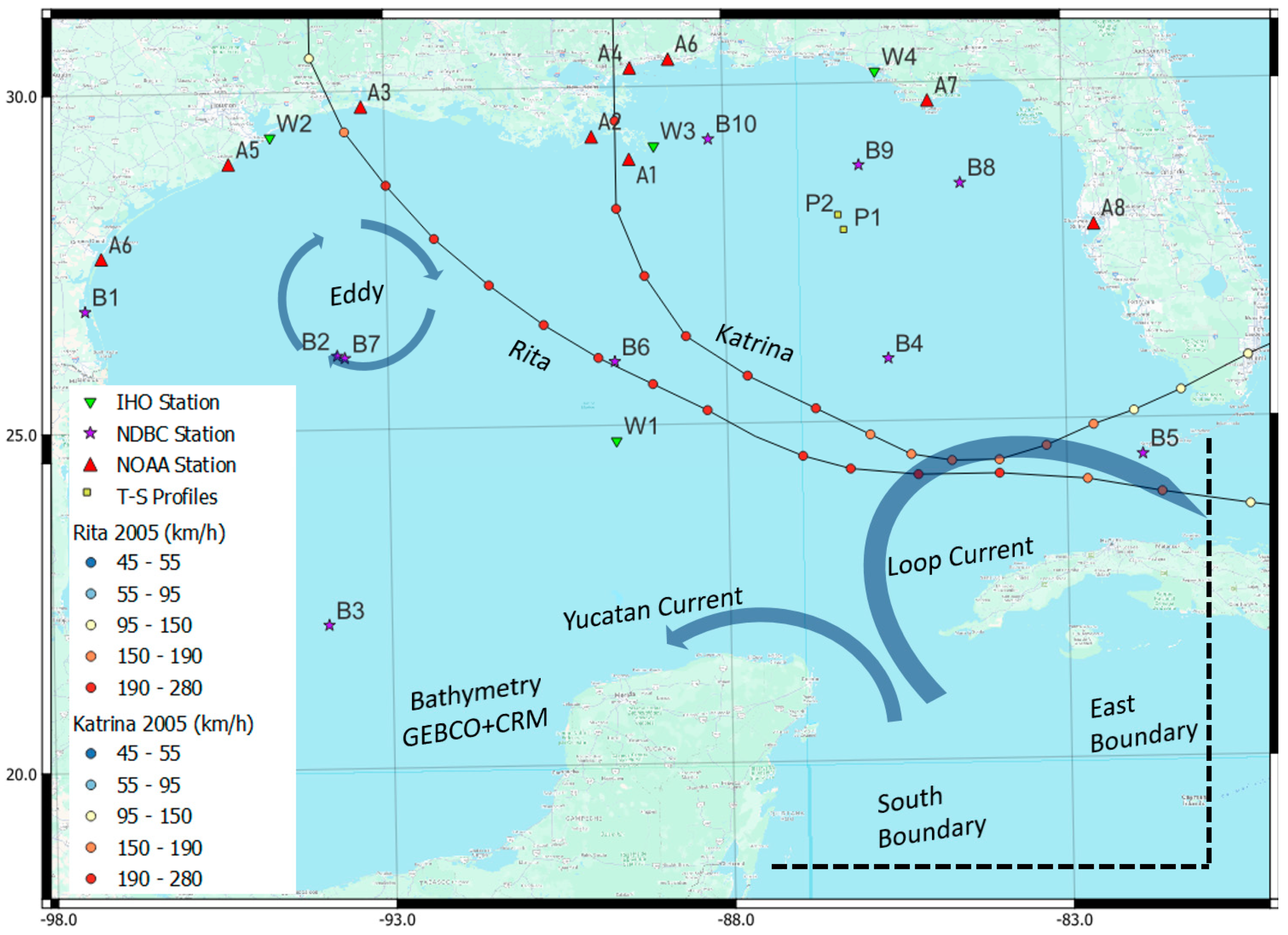

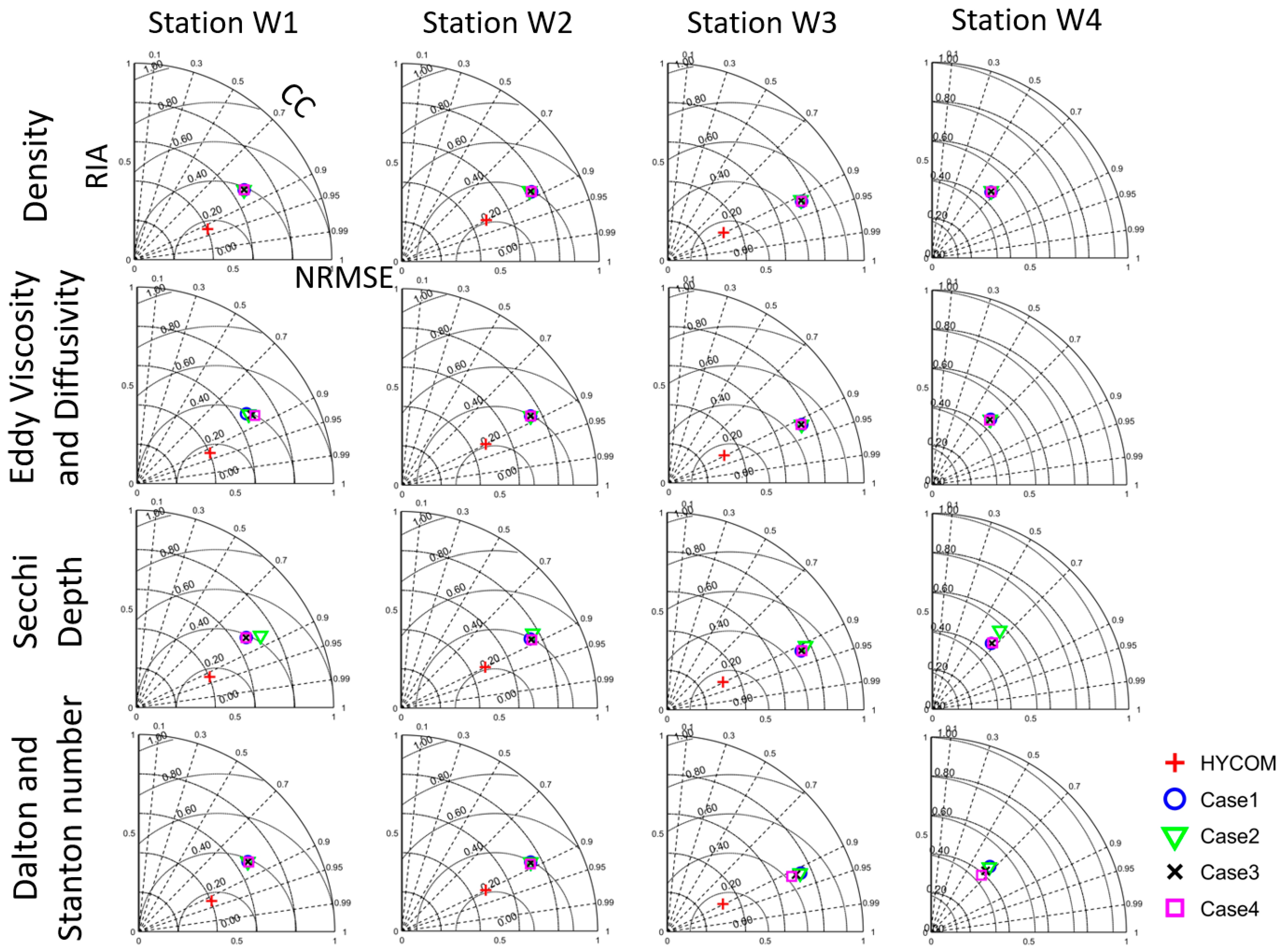

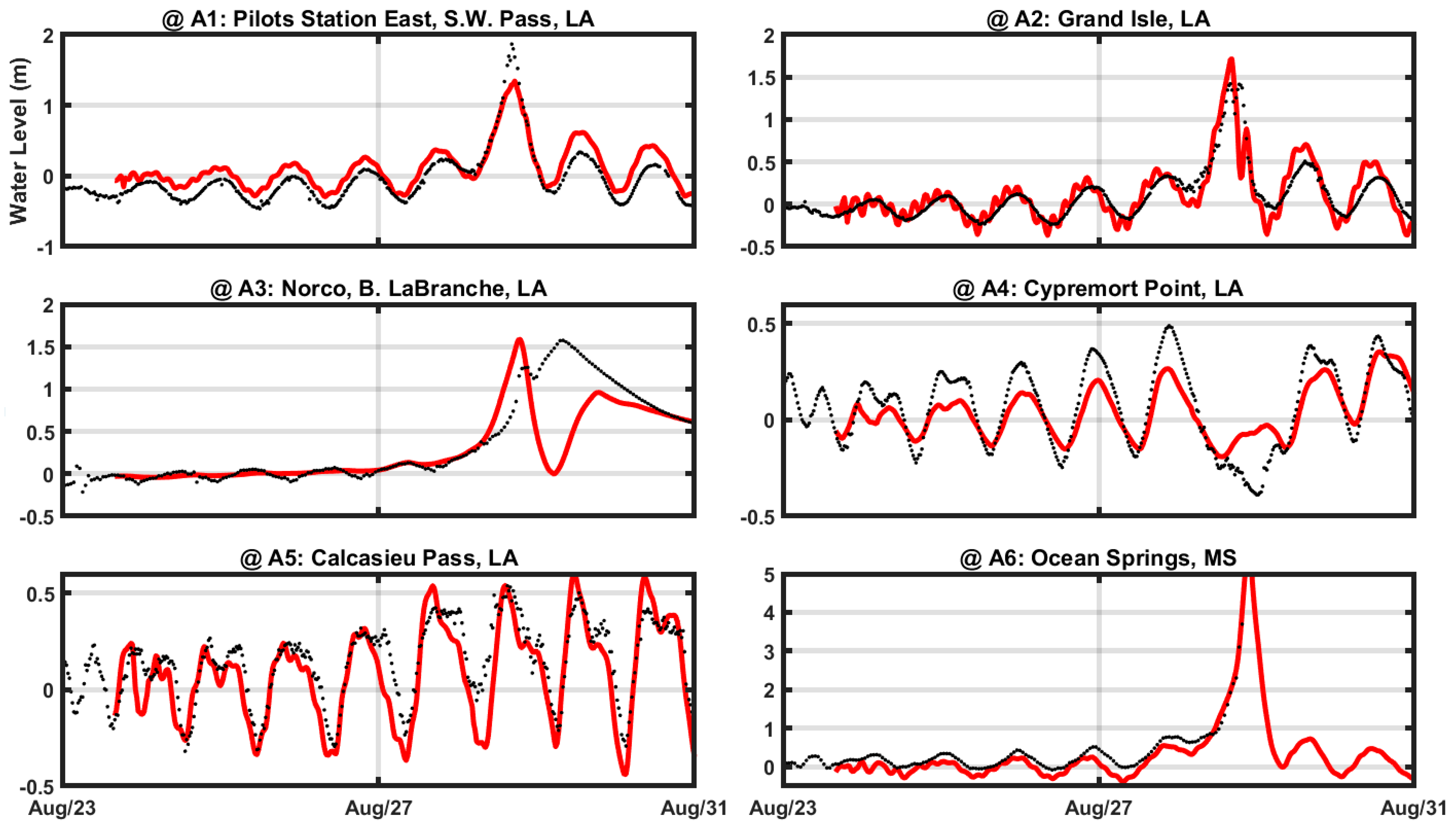
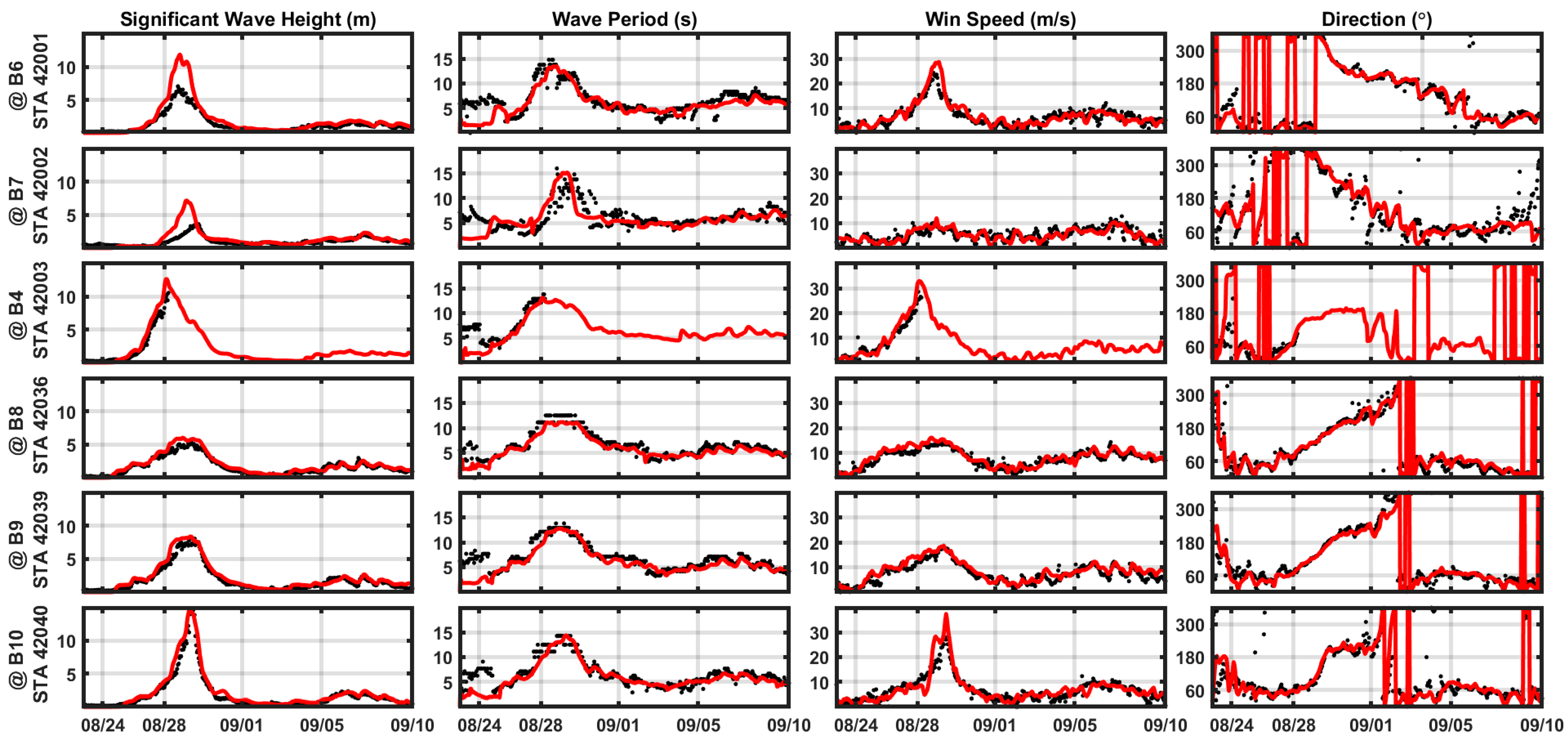

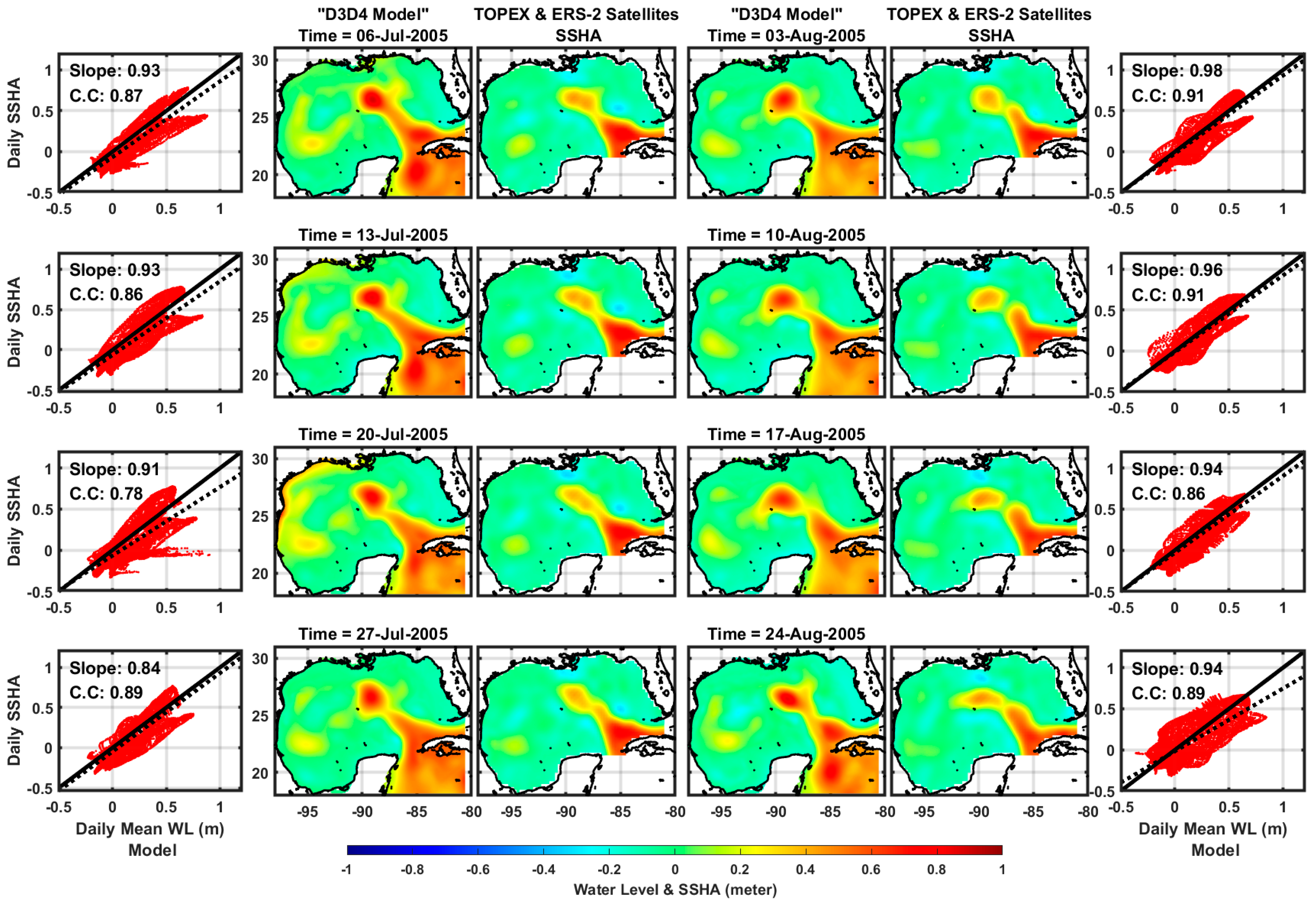
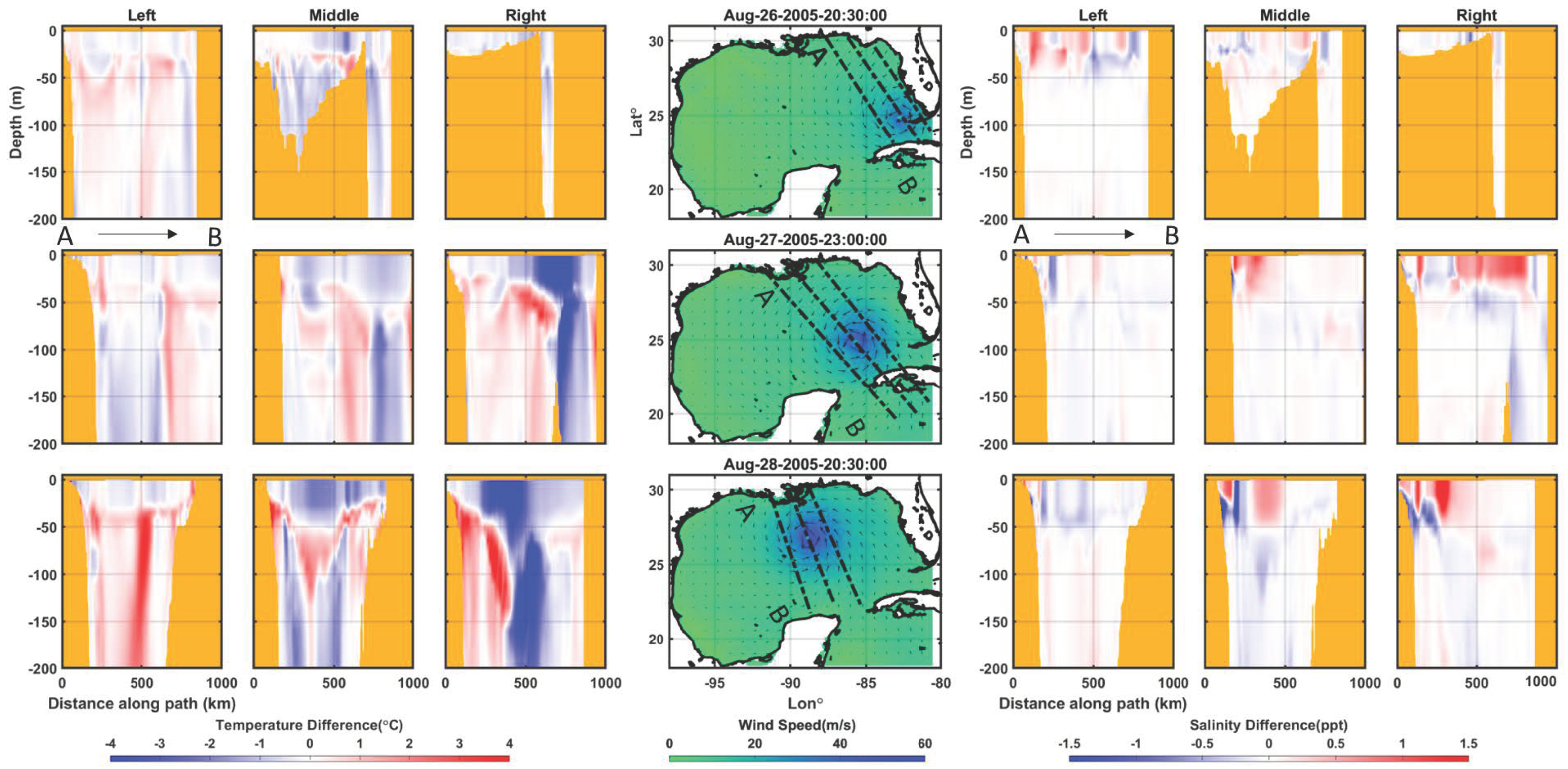

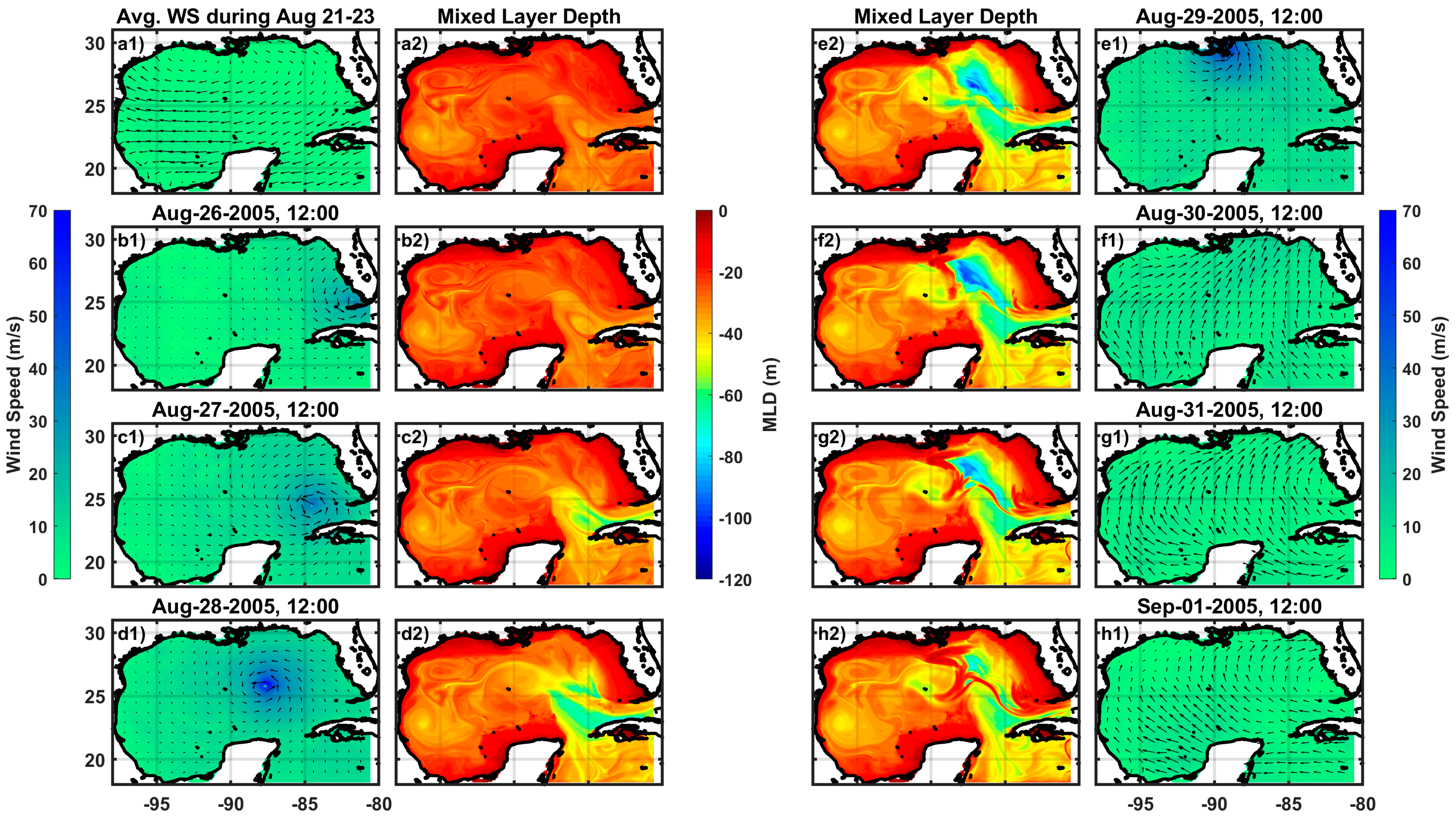

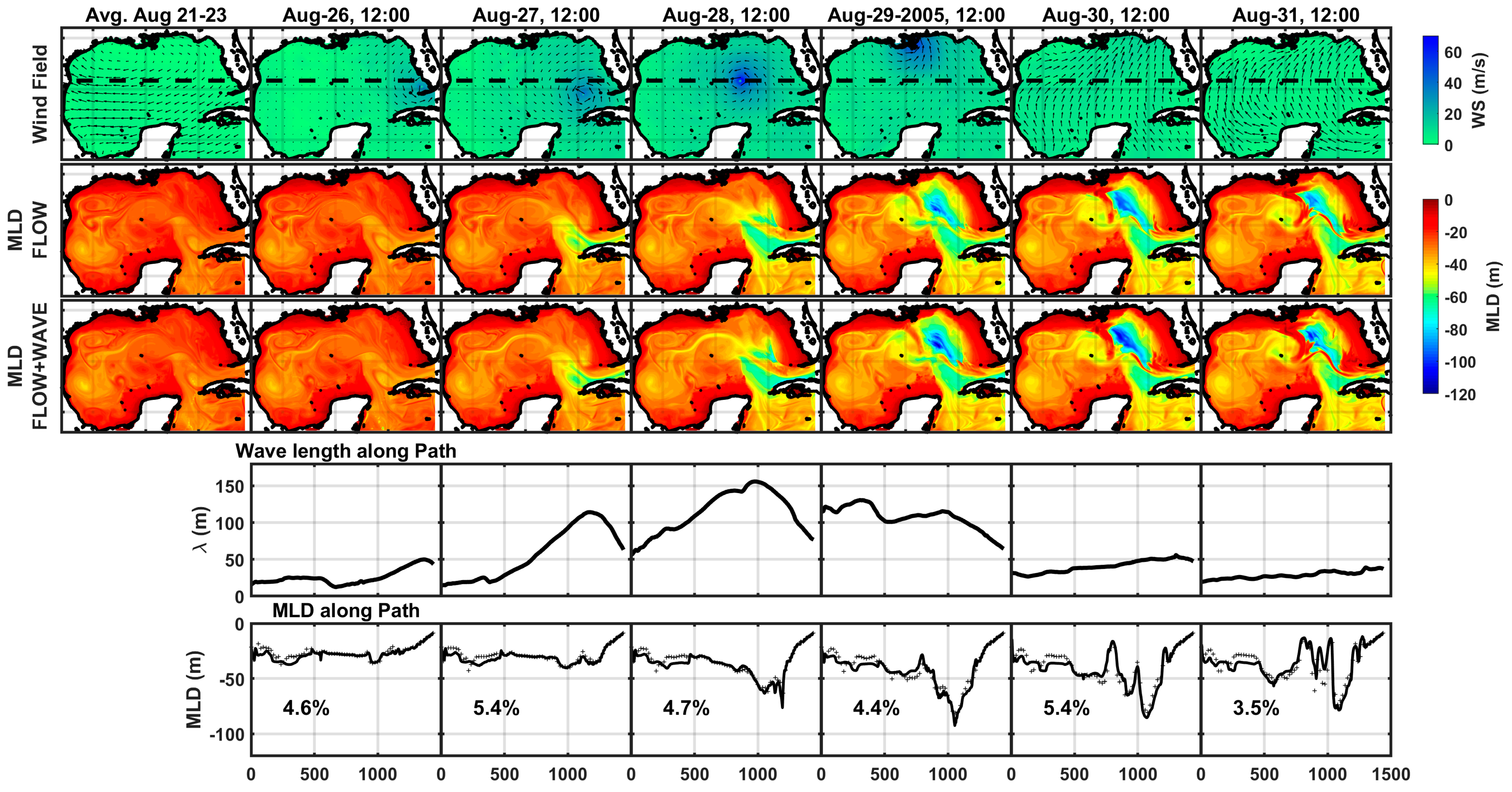
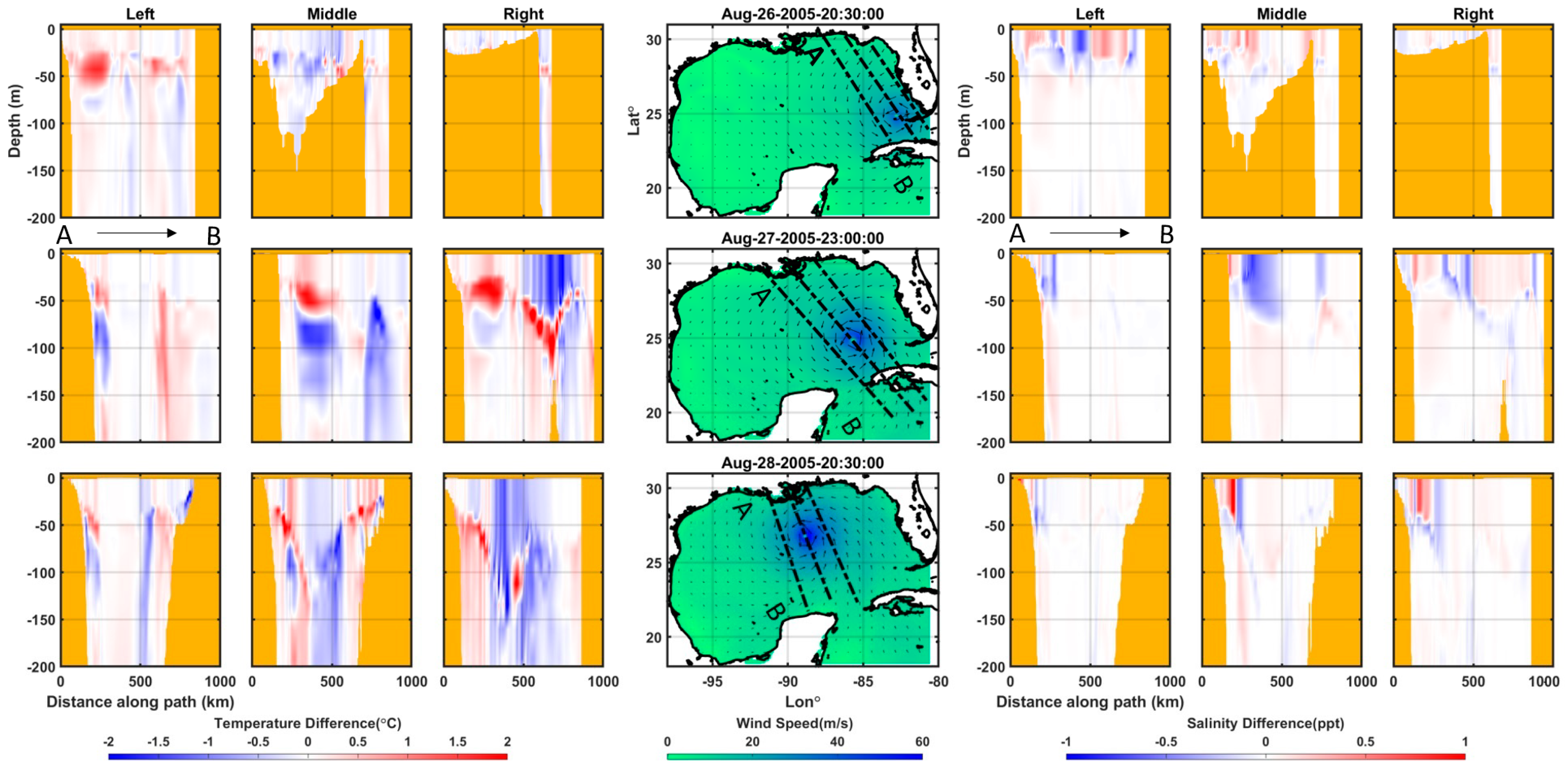

| Dalton | 0.0041 |
| Stanton | 0.0041 |
| Air Density | 1.15 kg/m3 |
| Bottom Roughness | Manning’s Formula |
| Water: 0.02, Land: 0.08 | |
| Secchi Depth | 15 m |
| Background Horizontal | |
| Viscosity | 10 m2/s |
| Diffusivity | 10 m2/s |
| Parameter | Value 1 | Value 2 | Value 3 | Value 4 |
|---|---|---|---|---|
| Eddy Viscosity/Diffusivity (m2/s) | 01/01 | 05/05 | 10/10 | 15/15 |
| Secchi Depth (m) | 3.5 | 5.0 | 10.0 | 15.0 |
| Dalton and Stanton Number | 0.0013/0.0013 | 0.0014/0.0014 | 0.0041/0.0041 | 0.0098/0.0098 |
| Lat | Lon | Parameter | RMSE | CC | RIA | |
|---|---|---|---|---|---|---|
| NOAA Stations (water level from mean sea level) | ||||||
| Corpus Christi, TX | 27.58 | −97.22 | Water level | 0.085 | 0.942 | 0.818 |
| Freeport, TX | 28.95 | −95.32 | ʺ | 0.081 | 0.942 | 0.831 |
| Calcasieu, LA | 29.77 | −93.35 | ʺ | 0.114 | 0.921 | 0.768 |
| Grand Isle, LA | 29.27 | −89.95 | ʺ | 0.118 | 0.855 | 0.643 |
| S.W Pass, LA | 28.93 | −89.40 | ʺ | 0.196 | 0.806 | 0.368 |
| Wave Land, MS | 30.28 | −89.37 | ʺ | 0.138 | 0.922 | 0.671 |
| Ocean Springs, MS | 30.40 | −88.80 | ʺ | 0.187 | 0.914 | 0.573 |
| Apalachicola, FL | 29.73 | −84.98 | ʺ | 0.267 | 0.848 | 0.321 |
| Tampa, FL | 27.87 | −82.55 | ʺ | 0.229 | 0.877 | 0.543 |
| Profiles (vertical structure of salinity and temperature) | ||||||
| Profile on 10 July | 27.79 | −86.20 | Salinity/Temperature | 0.18/0.85 | 0.999/0.999 | 0.89/0.92 |
| Profile on 19 July | 28.01 | −86.28 | ʺ | 0.26/0.69 | 0.926/0.996 | 0.89/0.92 |
Disclaimer/Publisher’s Note: The statements, opinions and data contained in all publications are solely those of the individual author(s) and contributor(s) and not of MDPI and/or the editor(s). MDPI and/or the editor(s) disclaim responsibility for any injury to people or property resulting from any ideas, methods, instructions or products referred to in the content. |
© 2024 by the authors. Licensee MDPI, Basel, Switzerland. This article is an open access article distributed under the terms and conditions of the Creative Commons Attribution (CC BY) license (https://creativecommons.org/licenses/by/4.0/).
Share and Cite
Lee, W.; Veeramony, J. The Response of Mixed Layer Depth Due to Hurricane Katrina (2005). J. Mar. Sci. Eng. 2024, 12, 678. https://doi.org/10.3390/jmse12040678
Lee W, Veeramony J. The Response of Mixed Layer Depth Due to Hurricane Katrina (2005). Journal of Marine Science and Engineering. 2024; 12(4):678. https://doi.org/10.3390/jmse12040678
Chicago/Turabian StyleLee, Wonhyun, and Jayaram Veeramony. 2024. "The Response of Mixed Layer Depth Due to Hurricane Katrina (2005)" Journal of Marine Science and Engineering 12, no. 4: 678. https://doi.org/10.3390/jmse12040678





